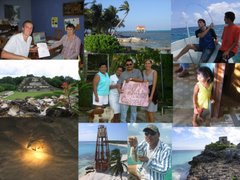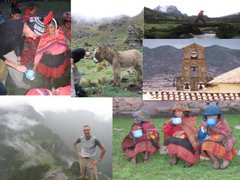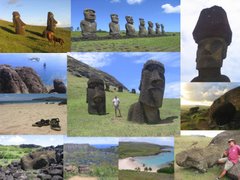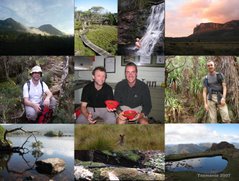
“Do I really have to read this thing? It’s painful just picking it up.” I hand over my 22,000-word report to BCVI Director, Mrs Joan Musa.
Between June and August of this year, I walked 500 miles around Scotland (and London), raising over £3,000 of funding towards a Challenges WorldWide organised project with the Belize Council for the Visually Impaired. Now that the project is completed, what d

id all that fundraising achieve? Was it worth it?
When I arrived on the 7th of September my goal was to “develop a financial plan incorporating forecasts and financial planning advice to ensure financial sustainability for BCVI.”
Over the following three months, I carried out research into the eye-care sector in Belize, interviewed BCVI staff, and developed a financial model based on BCVI’s accounting system. The key outputs were (1) a 65-page report setting out all my findings, providing financial forecasts for BCVI to 2010 and setting out 9 key recommendations to help ensure future financial sustainability and; (2) a spreadsheet-based model, which BCVI staff will be able to use in future to carry out their own financial modelling.
The feedback I’ve had so far has been very positive – in the short term, BCVI’s director plans to share the report with BCVI’s key funders in advance of discussions about BCVI’s future funding. In the longer term, I hope some of the recommendations I’ve made will be adopted and will help strengthen BCVI’s finances. This will help BCVI extend their lifeline services to an even greater share of Belize’s poor population.


LEFT: Dana, Vic, Joan Samuels, Lisa, Joan Musa and Kaiser Sose
RIGHT: Dana takes Christa’s place behind the camera. Hi to Naomi and Mark who weren’t in on my last day.
Hope this reassures everyone who made a donation that the money was well spent, especially those of you who were beginning to suspect that your donations had gone into a slush fund to finance deep-sea diving, rampant consumption of rum/belikin, and the bribing of border guards.


What it’s all about. BCVI and CARE at work
Travelling in Belize has been superb
And I managed to get to Mexico, Guatemala and Honduras as well.
Mexico


Honduras…

…And Belize


 And lastly (new) Friends and Family
And lastly (new) Friends and Family
It was a real stroke of luck to stay with Evan and Mari. They fed me, entertained me and looked after me, and put up with my dodgy Spanish for three months - above and beyond the call of duty. I am extremely grateful.
I’ve made some great friends here. Hope it all goes well for Karin back in Sweden, Kirsty - who’s done a great job cataloguing the history of the Red Cross here and has made a superb documentary about it – and Dorothy, who’ll be here for almost another two years with Peace Corps.

And I will especially miss my long-suffering (at least as long as I was driving) travelling companion Teri.

Maybe the 3 months have passed pretty quickly, but it honestly feels more like I’ve been here for a year. I’ve really enjoyed life in Belize – if I win the lottery I’m coming back to do this permanently. But for now I have to move on.
Next stop deepest, darkest Peru. I’ll be out of email contact whilst in the mountains so I just want to say have a fab Christmas and New Year. Please keep in touch and I’ll be back online soon.
 The air is so clear on Lake Titicaca that the views are of a different order to anywhere else and photography takes on an unbelievable clarity. And there are some bizarre and unique photo opportunities too.
The air is so clear on Lake Titicaca that the views are of a different order to anywhere else and photography takes on an unbelievable clarity. And there are some bizarre and unique photo opportunities too. The Uros Islands definitely fall into the
The Uros Islands definitely fall into the  bizarre and unique category. The islands are man-made by a Quechua speaking tribe who were contemporaries of the Incas. Constructed from reeds, the islands can be visited by boat from the mainland, though their exact location can be changed as the islanders can up-anchor and move around the lake, presumably if they take a fancy for a change of scenery.
bizarre and unique category. The islands are man-made by a Quechua speaking tribe who were contemporaries of the Incas. Constructed from reeds, the islands can be visited by boat from the mainland, though their exact location can be changed as the islanders can up-anchor and move around the lake, presumably if they take a fancy for a change of scenery. 
 At one point we have to cross an inlet of the lake. As a first experience of Bolivian infra-structure, the crossing is an eye-opener. Vehicles are punted across the river in ones and twos on pontoons, while bemused travellers cross separately via a fleet of speedboats. The photo shows the Dragoman truck with Dan, our guide and driver, catching 40 winks on the roof.
At one point we have to cross an inlet of the lake. As a first experience of Bolivian infra-structure, the crossing is an eye-opener. Vehicles are punted across the river in ones and twos on pontoons, while bemused travellers cross separately via a fleet of speedboats. The photo shows the Dragoman truck with Dan, our guide and driver, catching 40 winks on the roof. The communities on Isla del Sol are fascinating. Ali and I stumbled across this town meeting in our trek across the island. We got some strange looks. Of course this was before I became a star of Bolivian tv...
The communities on Isla del Sol are fascinating. Ali and I stumbled across this town meeting in our trek across the island. We got some strange looks. Of course this was before I became a star of Bolivian tv... 









 Hadn´t done much travel planning beyond Belize - I thought Cusco was a small town, not a city of 500,000 people – doh. (Wearing my BCVI t-shirt in this pic!)
Hadn´t done much travel planning beyond Belize - I thought Cusco was a small town, not a city of 500,000 people – doh. (Wearing my BCVI t-shirt in this pic!)
 Our first stop was in Quisharani, a village of a couple of hundred people at a height of 3,850 metres. We were dropped off by our bus with all our possessions for the next 3 days in the wilderness. After two days in Cusco I´d gotten over the tiredness, loss of apetite (no really!) and breathlessness at 3,300 metres, but this was higher still. A restless night under an incredibly clear, star-filled sky followed. But in the morning, the views were spectacular.
Our first stop was in Quisharani, a village of a couple of hundred people at a height of 3,850 metres. We were dropped off by our bus with all our possessions for the next 3 days in the wilderness. After two days in Cusco I´d gotten over the tiredness, loss of apetite (no really!) and breathlessness at 3,300 metres, but this was higher still. A restless night under an incredibly clear, star-filled sky followed. But in the morning, the views were spectacular. 
 The first night at altitude was bad. And we had barely started the trek the next morning when the effects of altitude on the body became clear. By the time we reached the peak for that day at 4,500 metres, one of our group of seven had spent most of the day on the emergency donkey and two of the others were struggling badly.
The first night at altitude was bad. And we had barely started the trek the next morning when the effects of altitude on the body became clear. By the time we reached the peak for that day at 4,500 metres, one of our group of seven had spent most of the day on the emergency donkey and two of the others were struggling badly.














 Honduras…
Honduras…

















 Cahal Pech
Cahal Pech






